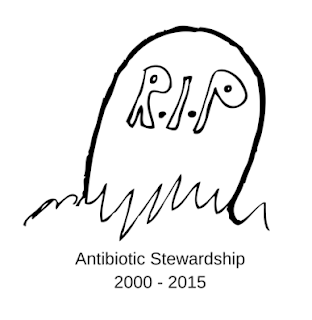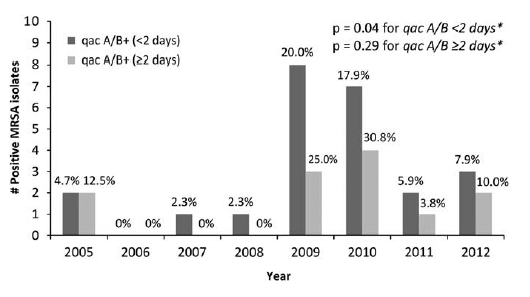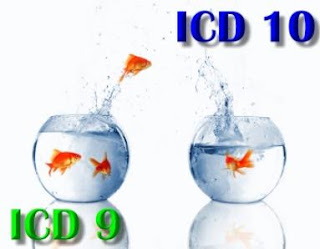Killing antimicrobial stewardship (part 2)
A few days ago, I posted a piece regarding the 21st Century Cures Act, which would provide incentives to hospitals to use new antibiotics. This is terrible policy, in my opinion. Through comments on Twitter and this blog, as well as conversations with colleagues, there was concern raised that my cited source was incorrect. While the New York Times is not infallible, it's pretty damn good. In all honesty, I read the text of the bill myself before posting but found it unintelligible (maybe I was too tired at the time).
Anyway, a highly reputable group, the Center for Disease Dynamics, Economics and Policy (CDDEP), has bailed me out. They cite the same sentence from the New York Times editorial that I did in my previous post, and add, "We at CDDEP couldn't agree more." Even better, they argue that stewardship not development of new drugs is the ultimate solution to the antibiotic resistance crisis. I highly recommend their post, which you can find here.
Anyway, a highly reputable group, the Center for Disease Dynamics, Economics and Policy (CDDEP), has bailed me out. They cite the same sentence from the New York Times editorial that I did in my previous post, and add, "We at CDDEP couldn't agree more." Even better, they argue that stewardship not development of new drugs is the ultimate solution to the antibiotic resistance crisis. I highly recommend their post, which you can find here.




36 compounds in development may sound like a lot, but on a probability-of-approval adjusted basis that means 12, and most of these do not address key issues such as non-fermentative GNRs or MBL producers. Only three compounds are in development for gonorrhea, which on a probability adjusted basis suggests a single approval. Historically, CDC recommended regimens for gonorrhea have shifted about every 5 years due to resistance development. Three of the 20 compounds in Phase 2 or Phase 3 development are topical, 5 lack Gram negative activity, and another 4 appear to be in development in name only, with no active work done in several years.
ReplyDeleteLooking over the Phase 3 and Phase 2 candidates:
Carbavance (Phase 3) is a combination of a marketed carbapenem (RPX2014) and a boronate beta-lactamase inhibitor (RPX7009). It has limited effect on AmpC or extended-spectrum beta-lactamases, and has no effect on metallo-beta-lactamases.
Delafloxacin (Phase 3) is a fluoroquinolone in development for Gram positive infections. Not a lot has been disclosed, but it does not appear to have remarkable Gram negative activity
Ceftobiprole (nominally in phase 3) suffered from irregularities in its phase 3 program that prevented its FDA approval. Due to limited patent life, it appears unlikely that the trials will be repeated and approval gained.
Eravacycline (Phase 3) is a tigecycline analog, and thus is likely to share the latter drug’s black box warning against use in serious infections. It lacks useful activity against Pseudomonas
Solithromycin (Phase 3) is a macrolide that is unlikely to be useful for hospital acquired Gram negative pathogens. Nice activity against gonorrhea and (in vitro) VRE though
SYM-1219 (Phase 3) is a nitroimidazole derivative solely for the treatment of vaginal bacteriosis. Very little about it has been disclosed
Xifaxan (Phase 3) is a topical drug in development for bacterial vaginosis only.
Auriclosene (Phase 3) is another topical drug, being developed for ophthalmologic infections
Iclaprim (Phase 3) is a dihydrofolate reductase inhibitor in development for HAP and skin infections. It lacks activity against most gram negatives
AN-3365 (nominally in Phase 2), a tRNA synthesase inhibitor, is listed as being in active development by the sponsor, but no trials have been ongoing since it was shown to induce rapid resistance development in Phase 2
AZD0914 (Phase 2) is a gyrase inhibitor that generally lacks Gram negative activity. It might be useful for gonorrhea, the sole indication for which it is in development
GSK2140944 (Phase 2) is a topoisomerase inhibitor. Like AZD0914, it lacks Gram negative activity
Omadacycline (Phase 2) is very similar to Eravacycline. It is in development for community acquired infections only
Plazomicin is an am(Phase 2) inoglycoside analog that is in development for serious gram negative infections including CRE. It is a nice addition
relebactam/imipenem/cilastatin (Phase 2) is a carbapenem-beta lactamase inhibitor. It is a nice addition. The beta lactamase inhibitor does not work for MBLs
benzoxazinorifamycin (nominally in Phase 2) is an RNA polymerase inhibitor in development for urinary tract infections, but no active development work has been ongoing for over 2 years
S-649266 (Phase 2)is a beta lactam that makes use of iron import channels to overcome outer membrane permeability barriers. A similar compound was recently shown to induce rapid resistance development by downregulation of the iron channels
Teflaro-avibactam (nominally Phase 2)is another ceph-beta lactamase inhibitor combo. No active clinical development work has been performed since 2013.
Finafloxacin (Phase 2) is a new fluoroquinolone. It worked well in a small trial in Europe
TD-(Phase 2) 1792 is glycopeptide and cephalosporin conjugate antibiotic that lacks Gram negative activity
This comment has been removed by the author.
ReplyDelete